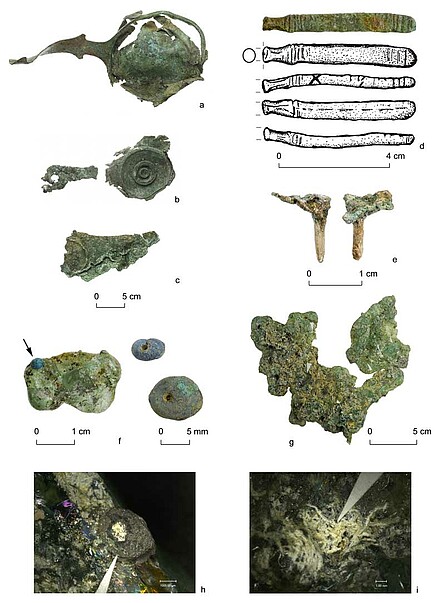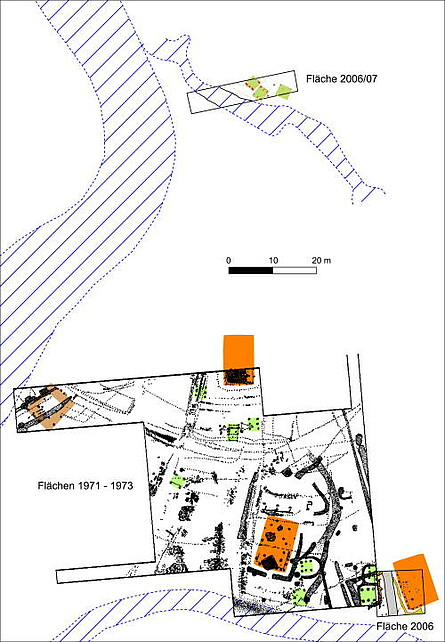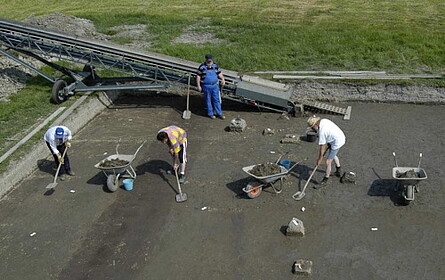
Bentumersiel – Romans and Germanic People
Ever since its discovery in 1928, the settlement site of Bentumersiel, located on the western bank of the Lower Ems, has occupied a special place within archaeological research because it also yielded numerous objects of Roman origin. Apparently, the settlement held particular significance for the Roman army during the military campaigns of Germanicus in AD 15/16. Renewed archaeological investigations between 2006 and 2008 were carried out with the aim of establishing a detailed understanding of the settlement’s function and development. Coordinated by E. Strahl, the project is carried out in cooperation with the Roman-Germanic Commission of the German Archaeological Institute in Frankfurt/Main. The work was funded by the EWE-Foundation, Oldenburg, and supported by the Centre for Work of Leer District.
The site has produced, amongst others, fragments of tuyères for smelting furnaces as well as numerous items of Roman origin dating to the 1st–2nd/3rd centuries AD. There are several metal fragments of Roman legionary equipment dating to the early 1st century AD, alongside sherds of amphorae or Roman dolia. These finds can be linked with Germanicus’ military campaigns in the area to the East of the Ems in AD 15/16. According to Tacitus’ account the Roman fleet remained on the lower reaches of the river for the time of the campaigns. Finds of pottery and a small assemblage of bronze objects displaying Celtic influences suggest that the settlement had been established as early as the 3rd/2nd century BC. Based on current evidence it continued into the 4th century AD. With its rich Roman import an isolated cremation grave dating to the same period is a peculiarity in the West Germanic area between the rivers Weser and Ems. Among the grave goods, which had been heavily fire-damaged on the pyre, there are three bronze vessels and, apart from glass beads, probably also several glass vessels as indicated by molten glass weighing nearly 1 kg. On the basis of a Germanic composite comb the burial can be dated to the early 4th century AD. Several other equally isolated cremation graves of similar date were uncovered by the Archaeological Service of the East-Frisian Landscape in the course of investigations of the Wurt mound of Jemgumkloster, located immediately to the North of Bentumersiel.
Bibliography
Jöns, H., 2009: Organisation of communication and exchange between the coastal area and the hinterland in Northern Germany during the 1st millennium AD. C. J. C. Reuvenslezing 21 (Amsterdam 2009).
Jöns, H., 2009: Überlegungen zu Transport- und Kommunikationswegen des 1. Jahrtausends im nordwestdeutschen Nordseeküstengebiet. In: S. Brather, Geuenich u. C. Huth (Hrsg.), Historia Archaeologica. Festschrift für Heiko Steuer zum 70. Geburtstag.. RGA-Ergänzungsbände 70 (Berlin 2009) 389-414.
Mückenberger, K., u. Strahl, E. , 2010: Ein Brandgrab des frühen 4. Jahrhunderts n. Chr. mit reichem römischen Import aus Bentumersiel, Lkr. Leer (Ostfriesland). – Archäologisches Korrespondenzblatt 39, 2009, 547-558.
Strahl, E., 2009: Germanische Siedler - Römische Legionäre. Die Siedlung Bentumersiel im Reiderland. Varus - Kurier 11, 2009, 12-15.
Strahl, E., 2011:Neue Forschungen zum germanischen „Stapelplatz“ von Bentumersiel an der unteren Ems / New research on the Germanic ‘emporium’ at Bentumersiel on the lower River Ems. – Siedlungs- und Küstenforschung im südlichen Nordseegebiet 34, 293-306.


